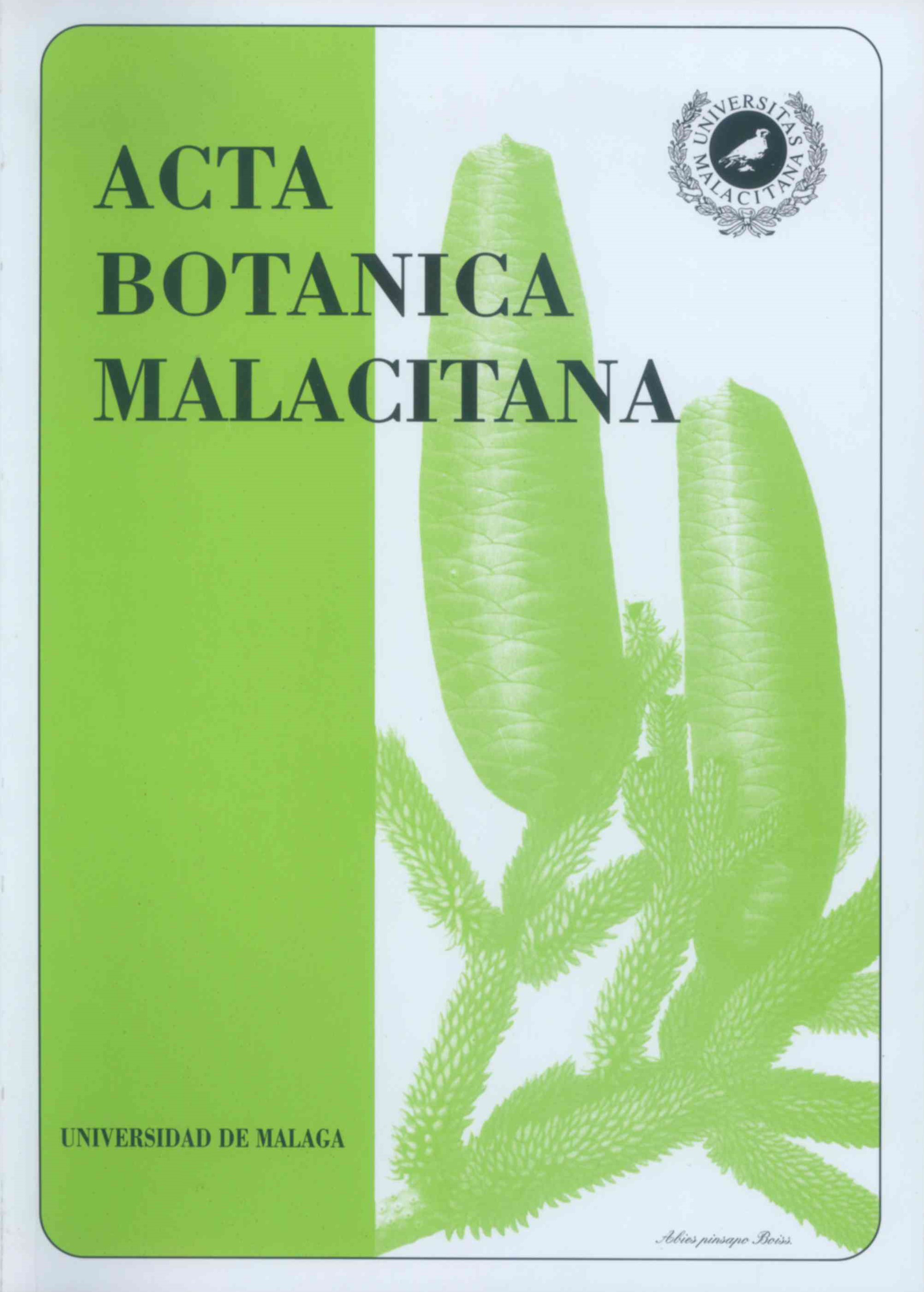Análisis del contenido aeropolínico estival en la provincia de Málaga
DOI :
https://doi.org/10.24310/abm.v26i0.7402Mots-clés :
aerobiología, verano, turismo, alergia, polen, Málaga, sur de EspañaRésumé
En el presente trabajo se realiza un estudio del contenido polínico de la atmósfera de la provincia de Málaga durante cl periodo estival (Julio-Septiembre) tomando los registros obtenidos durante los últimos años en varias localidades de la provincia: Málaga (1992-1999), Estepona (1995-1997), Antequera (1998-1999) y Nerja (2000). En general, durante estos tres meses se recoge sólo entre el 3 y el 6% del polen anual, estando el espectro aeropolínico estival de Málaga representado básicamente por 14 tipos polínicos: Eucalyptus, Castanea, Parkinsonia, Cannabis, Apiaceae, Ligustrum, Chenopodiaceae-Amaranthaceae, Palmae, Compositae, Artemisia, Typha, Cyperaceae, Poaceae y Urticaceae. Los tipos que alcanzan mayores concentraciones son Eucalyptus, Chenopodiaceae-Amaranthaceae y Poaceae. El resto de los taxa citados aparecen en concentraciones muy bajas. Determinados taxa presentan concentraciones más elevadas en determinadas estaciones de muestreo: Castanea y Compositae en Antequera, Palmae y Parkinsonia en Málaga, y Artemisia en Nerja. La evolución a lo largo de los tres meses muestra, en general, dos tipos de tendencia: una descendente de Julio a Agosto (presente en todos los tipos polínicos estudiados, excepto en Artemisia y Palmae, y en todas las zonas estudiadas) y otra ascendente, de Agosto a Septiembre, de pequeña intensidad, aunque muy acusada para los dos tipos anteriores y para Chenopodiaceae-Amaranthaceae y Compositae. La mayoría de los tipos polínicos estudiados tienen sus máximos diarios en primavera, estación del año con mayor concentración polínica en el sur de Europa, excepto Eucalyptus, Castanea, Parkinsonia y Cannabis, que generalmente lo tienen en verano, y que alcanzaron máximos históricos relevantes: Eucalyptus en 1994 (112 granos/m3), Castanea en 1997 (233 granos/m3), Cannabis en 1998 (28 granos/m3).
Téléchargements
Métriques
Références
CABEZUDO, B., M. M. TRIGO, M. RECIO y F. J. TORO -1994- Contenido polínico de la atmósfera de Málaga: Años 1992 y 1993. Acta Bot. Malacitana 19: 137-144.
CABEZUDO, B., F. J. TORO, M. RECIO y M. M. TRIGO-1998- Aerobiología en Andalucía: Estación de Estepona (1995-1996). Rea 3: 37-40.
DOMÍNGUEZ VILCHES, E., C. GALÁN SOLDEV1LLA, F. VILLAMANDOS DE LA TORRE & F.INFANTE GARCÍAPANTALEÓN -1991- Handling and evaluation of the data from the aerobiological sampling. Monografías REA/EAN 1: 1-18.
HIRST, J. M. -1952- An automatic volumetric spore trap. Ann. Appl. Biol. 39: 257-265.
MANDR1OLI, P. & M. G. NEGRINI -1991- Weather and climate in Europa. In: G. D'AMATO, F. TH. M. SPIEKSMA & S. BONINI (eds.) Allergenic pollen and pollinosis in Europe, pp. 3-17. Blackwell Scientific Publications, Oxford.
NILSSON, S. & F. TH. M. SPIEKSMA, (eds.) - 1992- Traveller's Allergy Service Guide. Swedish Museum of Natural History and Fisons Sweden AB, Sweden.
RECIO, M., M. M. TRIGO, F. J. TORO y B. CABEZUDO -1995-. Contenido polínico de la atmósfera de Málaga: Año 1994. Acta Bot. Malacitana 20: 83-90.
RECIO, M., M. M. TRIGO, F. J. TORO y B. CABEZUDO -1998- Aerobiología en Andalucía: Estación de Málaga (1997). Rea 4: 41-44.
RECIO, M., M. M. TRIGO, F. J. TORO, L. BOOTELLO y B. CABEZUDO -1999- Aerobiología en Andalucía: Estación de Málaga (1998). Rea 5: 47 50.
RECIO, M., M. M. TRIGO, F. J. TORO, S. DOCAMPO y B. CABEZUDO -2000a-. estudio aerobiológico de la localidad de Antequera (Málaga, España): 1998-1999. Acta Bot. Malacitana 25: 1 65 - 174.
RECIO, M., M. M. TRIGO, S. DOCAMPO y B. CABEZUDO -2000b-. Aerobiología en Andalucía: Estación de Málaga (1999). Rea, 6: 43-46.
SPIEKSMA, F. TH. M. -1991- Regional European Pollen Calendars. In: G. D'AMATO, F. TH. M. SPIEKSMA & S. BONINI (eds.) Allergenic pollen and pollinosis in Europe, pp. 49-65. Blackwell Scientific Publications, Oxford.
TORO, F. J., M. RECIO, M. M. TRIGO y B. CABEZUDO -1996- Contenido polínico de la atmósfera de Málaga: Año 1995. Acta Bot. Malacitana 21: 57-630.
TORO, F. J., M. M. TRIGO, M. RECIO y B. CABEZUDO -1997- Contenido polínico de la atmósfera de Estepona (Málaga): Año 1996. Acta Bot. Malacitana 22: 115-122.
TORO, F. J., M. RECIO, B. CABEZUDO y M. M. TRIGO -1998- Aerobiología en Andalucía: Estación de Estepona (1997). Rea 4: 45-48.
TRIGO, M. M., M. RECIO, F. J. TORO y B. CABEZUDO -1998- Aerobiología en Andalucía: Estación de Málaga (1995-1996). Rea 3: 33-36.
TRIGO, M. M., F. J. TORO, M. RECIO, S. DOCAMPO y B. CABEZUDO -1999- Aerobiología en Andalucía: Estación de Antequera (1998). Rea 5: 51-54.
TRIGO, M. M., M. RECIO, S. DOCAMPO y B. CABEZUDO -2000- Aerobiología en Andalucía: Estación de Antequera (1999). Rea 6: 47-50.
Téléchargements
Publiée
Comment citer
Numéro
Rubrique
Licence
(c) Tous droits réservés Acta Botanica Malacitana 2019

Ce travail est disponible sous licence Creative Commons Attribution - Pas d’Utilisation Commerciale - Partage dans les Mêmes Conditions 4.0 International.
Toutes les informations concernant la licence d'utilisation des travaux publiés dans Acta Botanica Malacitana et les droits d'auteur sont disponibles dans notre Politique Éditoriale.







1.png)


